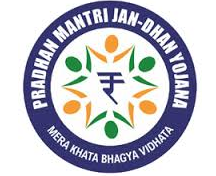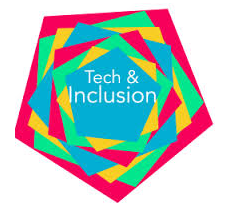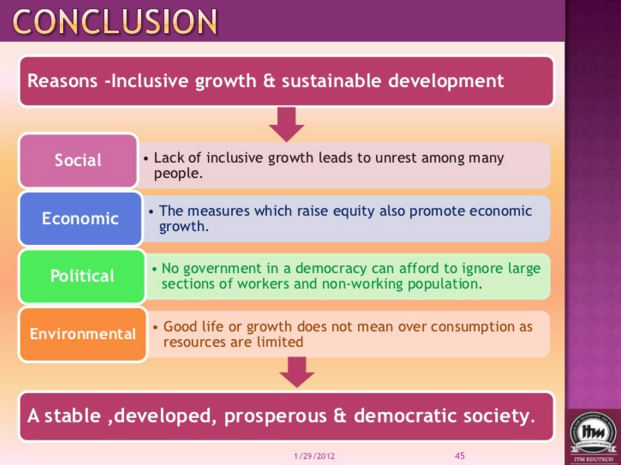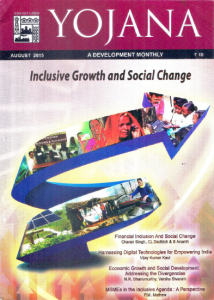This article covers the contents covered in the Yojana magazine, which is very important to handle topics in UPSC Civil Service Examination, related to Government schemes to uplift different sections of the Indian society. It provides details on the plans for inclusive growth through the perspective of finance, skill development, employment, agriculture; medium and small scale industries.
Aspirants would find this topic very helpful while preparing for the IAS Exam.
| Aspirants should begin their preparation by solving UPSC Previous Year Question Papers UPSC Previous Year Question Papers now!!
To complement your preparation for the upcoming exam, check the following links: |
Why talk about inclusive growth? (Chief Editor’s Desk) There is a gap between the pace and pattern of growth in India. The country’s progress on various fronts has not been translated into an overall improvement in life of poor and marginalized sections of society. India’s rank on UNDP’s Human Development Index is 135 which substantiate this fact. There is a need to share the benefits of the growth process. The concept was first envisaged in the Eleventh five year plan document and the 12th plan document highlighted this agenda.
Governmental Schemes and Policies for Inclusive Growth
-
- Pradhan Mantri Jan Dhan Yojana
- MUDRA (Micro Units Development and Refinance Agency)Bank
- SETU(Self Employment and Talent Utilization)
- Skill India
- Mahatma Gandhi National Rural Employment Guarantee Act (MGNREGA)
- Kisan Card
- Pradhan Mantri Krishi Sinchayee Yojana (PMKSY)
- National Agriculture Market (NAM)
- Pradhan Mantri Jeevan Jyoti Beema Yojana
- Pradhan Mantri Jeevan Suraksha Yojana
- Atal Pension Yojana(Social Security Schemes)
- Digital India programme(for delivering benefits even to the last person)
Table of Contents
- Inclusion through skill development
- Financial Inclusion
- Inclusion through technology
- Economic growth and social development: Addressing the divergences
- Inclusion of MSMEs (Micro, Small and Medium Enterprises)
- Employment and Inclusive Growth in India: Emerging Pattern a Perspectives
- Making Agriculture a Tool of Inclusive Growth
Inclusion through Skill Development
Financial Inclusion
Objective: to ensure universal access to a wide range of financial services like savings account, credit insurance(to pay off the debt in case of emergency or death) and pensions to provide services for businesses, education, retirement planning and insurance against risks including emergency loans. Schemes associated PMJDY Gold monetization scheme MUDRA DBT(Direct Benefit Transfer) Kisan Credit card A brief history of financial inclusion Dependency on moneylenders in rural areas have been concern from colonial times The Cooperative Credit Societies Act, 1904 was passed to provide a legal basis for cooperative credit societies. The All-India Rural Credit Survey, 1951-54 pointed out that in 1950-51, commercial banks provided only 0.9 per cent of the total credit to farmers. Efforts
- Nationalization of State Bank of India in 1955
- Nationalization of more banks in 1969 and1980
- The establishment of the National Bank for Agriculture and Rural Development (NABARD)
- The introduction of priority sector lending to increase the flow of credit to certain sectors including agriculture
- 2005: no-frill accounts (zero or low balance and charges accounts since renamed as Basic Saving Bank Deposit account in August 2012 and now Jan Dhan account)
- Following Rangarajan Committee Report 2008 banks were advised to –
- initiate ICT based Business correspondent model (BC model) to provide low-cost banking services at doorstep in remote villages
- create a roadmap to cover all the villages having population above 2000 by 2012 and all the villages having population between 1000 to 2000 by 2013
- ensure availability of at least four banking products in villages
- open at least 25 per cent of new branches in unbanked rural areas.
PMJDY (Banking Services to All)
PMJDY seeks to implement inclusion through a Mission-mode approach. The PMJDY
- offers Rupay Debit card and microinsurance
- emphasizes on banking coverage of households rather than coverage of villages.
The PMJDY can alter the manner in which benefits are delivered to citizens while concurrently creating a social security net for the poor and those working in the unorganised sector Jan Dhan, Aadhaar and Mobile (JAM)  JAM combined offer a unique opportunity that can facilitate a paradigm shift in our economy and society Examples:
JAM combined offer a unique opportunity that can facilitate a paradigm shift in our economy and society Examples:
- Aadhaar enabled micro-ATMs (BC outlets) offer an opportunity to use Rupay cards validated by biometrics to pay for purchases replacing cash. Each Rupay Card is to be provided with inbuilt Immediate Payment Service (IMPS) registration and Near Field Communications (NFC) tags to make this possible. Contactless fingerprint scanning (matching a valid fingerprint with an image stored in memory) can be used for authentication.
- “Anywhere Rations”, which enables a person to draw rations from any shop is also possible by linking the Civil Supplies Department’s database with Aadhaar
The Main players in financial inclusion
- Banks-BC
- Micro-finance institutions
- self-help groups
- post offices and
- MUDRA bank
BC (Banking correspondent) Model
The Advantages of BC Model are listed below
- Convenience
- lower transactions costs
- improved banking relationship visible in the form of higher loan recovery rates.
- helps the banks mobilise term deposits – most of which would otherwise have gone into a more risky investment
The Social Impact For the first time in India households can access their savings without the risk of losing them. This offers the household an opportunity to channelize their savings to areas like education, health and housing When invested in shady pyramid schemes and other informal instruments, the money is often lost. Problems lack of access points transaction limits on accounts opened through BCs the transaction limits placed on PMJDY accounts (Entitlements that the government transfers to the beneficiary through Direct Benefits Transfer (DBT) from various government agencies or LIC payments often exceed the daily transaction limits)
Technology for Inclusion
Initiatives: Digital India
The program charts a roadmap to a digital India where a digitally literal population can leverage technology for endless possibilities. One key area in the focus of the government is the development of broadband highways that will cover 250,000-gram panchayats by December 2016. The govt is also focused on providing universal access to mobile connectivity. Agriculture Modern technology can help in making agro-value chain from farmer to consumer more efficient and competitive. What can technology do? 1.genetically modified crops 2.precision farming(using sensors and GIS-based soil, weather, and water data to guide farming decisions) 3.mobile Internet-based farm extension and market information services 4.improvements to storage and distribution systems 5.providing crop loans and insurance to farmers. 6.digitization of land records Manufacturing The problems of finance, raw materials, land and linkages with the user markets need faced by the MSMEs can only be resolved by technological intervention. GST, when adopted, can be implemented only with the help of sound technology. Technology can simplify processes and increase the ease of doing business. Manufacture needs innovation and new inventions in science and technology to become globally competitive This would in turn require investment in education and research Education Innovative digital technologies have created new forms of adaptive and peer learning, increasing access to trainers and mentors, providing useful data in real-time.New technology can also be used to build teachers’ and mentors’ capacity. There is an immediate need to integrate technology into our vast and complex school system and higher education institutional network. It involves the production of e-content such as digitized textbooks, animations and videos.Blended learning with MOOCs (massive open online courses) can bring high-quality courses to students, and learning simulations can boost hands-on training The next is to include tech-related aspects in teacher training, development of e-content and encouraging collaboration in the tutelary community. The next would be the role of technology in evaluation.With robust Management Information Systems, all educational institutions can record, maintain, track and analyse student-level performance data and use it for institution-wide goals as well as teacher-classroom-specific goals. Health Technologies could transform the delivery of public health services- extend care through remote health services (delivering expert consultations via the mobile Internet), digital tools can enable health-care workers with modest skills to carry out basic protocols, and low-cost diagnostic devices can work with just a smartphone. For instance, it is possible to convert the smartphone into an affordable eye test solution. Governance Technology can cut down delays, corruption and inefficiency in the delivery of a public service.Computerization of land records,e filing of taxes, cashless fund transfer for all government schemes,e bill payment, e toll payment, tap and go transit cards for transport systems etc are all in the pipeline. The Unified Payments System for fund transfer using apps smartphones linked to bank accounts has been launched by the National Payments Corporation of India In order to achieve the full benefit of the new modern technologies, there are certain prerequisites like providing basic digital education, building physical infrastructure(eg.broadband) India is a multilingual country, there is a need to weave multi-lingual capabilities to spread information, knowledge and opportunities. There is also a need to integrate traditional systems into modern systems that will simplify various aspects of governance—be it building an efficient public distribution system, automating work, transforming the urban-rural living environment or delivering better healthcare. Digital India Week July 1-7,2015: PM stressed upon the role of technology in delivering services and bringing about inclusion. Mckinsey Global Institute’s list of 12 empowering technologies for India categorized into 3 types: 1.Digitizing life and work
Mobile Internet
requiring mobile devices and internet connectivity to reach individuals and enterprises anywhere ii.Cloud technology Computing capacity, storage, and application delivered as a service over internet iii.Automation of knowledge related work Intelligent software for data analysis, language interpretation and judgment-based tasks to improve decision quality iv.Digital payments Widely accepted and reliable electronic payment systems to bring millions of unbanked Indians out of the cash economy v.Verifiable digital identity Digital identity that can be verified using simple methods, enabling secure delivery of payments and access to government services
Smart Physical Systems
Internet of things Networks of low-cost sensors and actuators to manage machines and objects, using continuous data collection and analysis vii.Intelligent transportation and distribution Digital services, used in conjunction with the internet of things, to increase efficiency and safety of transportation and distribution systems eg: smart cards used in metro stations viii. Advanced geographic information systems (GIS) Systems that combine location data with other types of data to manage resources and physical activities across geographic spaces ix.Next-generation genomics Fast, low-cost gene sequencing and advanced genetic technologies to improve agricultural productivity-improving India’s food and energy security
Rethinking energy
- Advanced oil and gas exploration and recovery
Techniques that make extraction of unconventional oil and gas (eg.shale) economical, potentially improving India’s energy security xi.Renewable energy generation of electricity from renewable sources to reduce harmful climate impact and bring power to remote areas not connected to the grid xii.Advanced energy storage Devices or systems of energy storage and management that reduce power outages, variability in supply, and distribution losses. A few other technologies—advanced robotics, autonomous vehicles, 3D printing, and advanced materials—are also potentially important for India.
Economic Growth and Social Development – Addressing the Divergences
GDP estimated for 2015-16:7.5% India’s performance on the Millennium Development Goals(MDGs): on track only in 4/18 indicators Root of the Problem: Programmes and policies are implemented for the redistribution of income among the poor not for the generation of income among them Consequence: Jobless growth with regional divergences Bihar boasts high growth in terms of GDP numbers but when it comes to MDGs-not doing well at all How to solve the problem? 1.Financial inclusion: the process of ensuring access to appropriate financial products and services to all at affordable cost in a fair and transparent manner. PMJDY was a successful project.it is being followed up by Central Financial Inclusion Plan(CFIP) which throws in the use of Aadhar and mobile phones to achieve the desired ends 2.Job creation: MGNREGA have employed poor and empowered women. Use of IT can streamline the implementation 3.Food Security India ranks 55/76(countries) in the Global Hunger Index. India has the world’s largest number of malnourished children. About a million kids below 5 die of malnutrition in India. How can we live with that? The NFSA integrated with PDS, Mid-day meal scheme and ICDS is yet to be implemented. There is a larger role for the state governments in bridging the gap now. With the increased resources at the state level, following 14th Finance Commission recommendations, and downsizing of Centrally Sponsored Schemes, it becomes crucial for the states to design and implement suitable schemes to bring in social development.
MSMEs in Inclusive Growth Agenda
The concept of a decentralised economic system based on local resources, businesses, opportunities and markets had taken shape in the course of the freedom movement The policies of the government to advance the cause of small enterprises were based on different ideologies in different times: protection and reservation-based (self-sufficiency principle) rights-based approach (local people cannot be deprived of resources in their locality) capabilities approach-MSMEs empowered to compete globally What is needed today: 1.integration of various programmes and focus on actual delivery without leakage. 2.special thrust to startups by i.skilling to create informed players ii.financial support iii.motivation to increase willingness to experiment and learn For instance the branding of Indian manufacture sector with concepts like ‘make in India’ with thrust to MSMEs 3.skill development to integrate to big manufacturing sectors like defence and electronics 4.Knowledge based development: MSMEs can survive if they learn to adapt and innovate. The best use of space and time is only possible through local knowledge 5. Define social enterprises, for-profit or not for profit to incentivise their operations so that activities that bring social changes are decentralised. For instance, enterprises can help India get over the problem of open defecation.
Employment and Inclusive Growth in India – Emerging Pattern and Perspectives
Patterns Only 18% of workers in India are employed informal sector. Of which only 7.5 % have social security 58% workers are casual and contract labourers Regional differences are striking. Central and eastern with more tribal population have more informal workers than all other parts Women face multiple problems. They are discriminated against in wages. They cannot migrate freely as Indian society is mostly patriarchal. Percentage of educated unemployed women are twice that of men Policies The growth process have to be reoriented and restructured Men and women have to be equipped with skills and health services made more accessible Governmental Initiatives categorised into: 1.Self-employment programmes(examples) i Swarna Jayanti Swarozgar Yojana (SGSY)-1999 ii the Prime Minister’s Employment Generation Programme (PMEGP)-2008 2.Wage Employment programmes i.the Mahatma GandhiNational Rural Employment Guarantee Act (MGNREGA) in 2005. Swarna Jayanti Shahari Rozgar Yojana (SJRY) consisting of two major components, namely urban self-employment programme (USEP), and urban wage employment programme (UWEP) Newer Initiatives Micro Units Development Refinance Agency (MUDRA) Bank The Bank will refinance Micro-Finance Institutions through a Pradhan Mantri Mudra Yojana and will have a corpus of Rs 20,000 crore, and credit guarantee corpus of Rs 3,000 crore. Priority to be given to SC/ST enterprises while lending. There are some 5.77 crore small business units. Deen Dayal Upadhyay Gramin Kaushal Yojana Deen Dayal Upadhyay Gramin Kaushal Yojana launched to cater to rural youth employment opportunities. Rs 1,500 crore have been set apart for this scheme. Disbursement will be through a digital voucher directly into qualified student’s bank account. Pradhan Mantri Vidya Lakshmi Karyakram With a view to enabling all poor and middle-class students to pursue higher education, a fully IT-based Student Financial Aid Authority is to administer and monitor Scholarship as well Educational Loan Schemes SETU (Self Employment and Talent Utilisation). SETU is a Techno-Financial, Incubation and Facilitation Programme to support all aspects of start-up businesses, and other self-employment activities, particularly in technology-driven areas, with an initial funding of Rs 1,000 crore Atal Innovation Mission (AIM) an Innovation Promotion Platform involving academics, entrepreneurs, and researchers and draw upon national and international experiences to foster a culture of innovation, R&D and scientific research in India. The platform will promote a network of world-class innovation hubs and Grand Challenges for India. Initially, a sum of Rs 150 crore will be earmarked for this purpose. The major limitation of these schemes is inclusion and exclusion errors due to the nature of targeting. The division of people between ‘below poverty line’ and ‘above poverty line’ is extremely defective. That is why only a universal social protection scheme, albeit excluding the easily identified better off groups, which provides some basic minimum will go a long way in attacking vulnerability and exclusion in the country. The socio-economic caste census combined with Aadhaar mechanism will considerably help in strengthening the effectiveness of the social protection system.
Making Agriculture a Tool of Inclusive Growth
Government Initiative for inclusion in Agriculture National Agriculture Market (NAM) A Central Sector Scheme for Promotion of National Agricultural Market through Agri-Tech Infrastructure Fund was approved on 2nd July 2015. The Government plans to integrate 585 wholesale markets across India by setting up an online platform and has earmarked Rs. 200 crore for three years from 2015-16 to 2017-18. “Now there will be one license for the entire state, there will be a single point levy. There will be electronic auctions for price discovery. The impact will be that the entire state will become a market and the fragmented markets within the states would be abolished,” said the Finance Minister.After the completion of NAM, the seamless transfer of agricultural commodities within the state can take place. The market size for farmers would increase as they won’t be limited to a captive market. Result: Farmers can sell more(bigger market) and get a better price(e-auctions), improve supply chain, reduce wastages and create a unified national market through provision of the common e-platform.Middlemen can be done away with. Soil Health Scheme: the scheme involves sample collection, sample analysis, training of chemists, staff and farmers, ICT investment.Mobile soil testing laboratories are set up and soil health cards are issued to farmers.On the basis of this card, instead of using Urea or some other fertilizer blindly, a farmer can decide the exact needs of his soil. This may not only reduce his cost significantly, but also save the health of his soil. And this may help him even in identifying the best crop suited for his soil. “The major objective of the Prime Minister Krishi SinchayeeYojana (PMKSY): PMKSY is to achieve convergence of investments in irrigation at the field level, expand cultivable area under assured irrigation (Har Khet ko pani), improve on-farm water use efficiency to reduce wastage of water, enhance the adoption of precision-irrigation and other water saving technologies (More crop per drop), enhance recharge of aquifers and introduce sustainable water conservation practices by exploring the feasibility of reusing treated municipal based water for peri-urban agriculture.This scheme can induce a sustainable model of water conservation and irrigation and can go a long way in ensuring social development. Price stabilisation fund The government has established a price stabilization fund with a corpus of Rs. 500 cr. According to government sources, commodities will be procured directly from farmers or farmers’ organizations right at the farm gate or mandi levels and be made available at reasonable prices to consumers using the fund Agriculture credit The government has increased the target of agriculture funding by Rs. 50,000 cr to Rs. 8.5 lakh crore. DD Kisan The government has launched a TV channel dedicated to the needs of farmers on 26 May 2015. Farm Insurance The Pradhan Mantri Fasal Bima Yojana (Prime Minister’s Crop Insurance Scheme) was launched on 18 February 2016. It envisages a uniform premium of only 2 per cent to be paid by farmers for Kharif crops, and 1.5 per cent for Rabi crops. The premium for annual commercial and horticultural crops will be 5 per cent. Warehouses National Bank for Agriculture and Rural Development (Nabard) aims to create a scientific storage space of 9.23 lakh tonne by construction of godowns and warehouses. E-Mandi It is an electronic market platform to sell the vegetables online at the best prices, for both the retailers and the whole sellers by providing a convenient way to keep the transparency in the whole marketing system. With the help of e-mandi project, the regulated markets across the country will be integrated with the common e-platform to provide farmers and traders like retailers and wholesalers with access to opportunities for purchasing or selling of agricultural commodities at the most favourable prices in a transparent manner across the country. With this, the chances of farmers being fooled by the marketers can be done away with. Apart from this, the private markets will also be allowed access to the e-platform thereby increase its outreach. The e-mandis will be set up by the Department of Agriculture & Cooperation through the Small Farmers Agribusiness Consortium through building a common electronic platform that will be used in selected regulated markets throughout the country. An amount of Rs. 200 crore has been allocated for the scheme from 2015-16 to 2017-18. A total of 585 selected regulated markets across the country will be covered as:250 mand is will be covered in 2015-16, 200 mandis in 2016-17 and 135 mandis in 2017-18.It will also include the supply for free software by Department of Agriculture & Cooperation to the UTs and the States and there will be a subsidy by the Government of India up to Rs. 30 lakh per Mandi for their infrastructure.Reforms possible in PDS expansion of PDS coverage, reduction in PDS prices, computerisation, doorstep delivery of grain, de-privatization of ration shops, and community management of FPS, setting up proper channels for grievance redressal and raising FPS commissions.

The above details would help candidates prepare for UPSC 2023.
Related Links
| IAS Salary | IAS Eligibility |
| UPSC Books | Static GK |
| Civil Service Exam | UPSC Syllabus |
| Best Optional Subjects for UPSC | 10 Must-Read Books for IAS Aspirants |


Comments